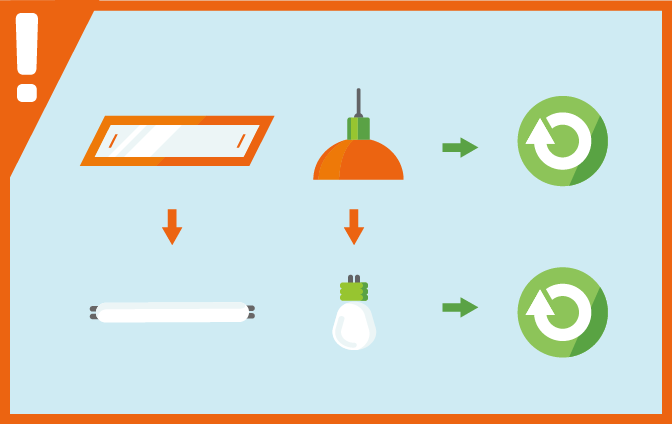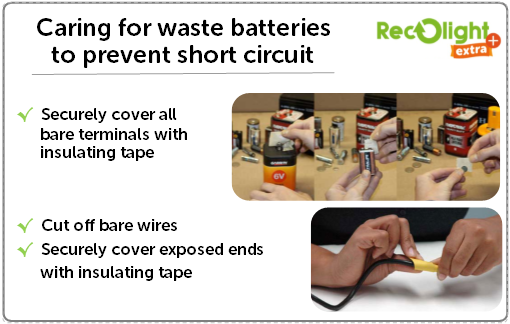Managing Your Site
Storing waste lamps, luminaires and batteries
For free collection and recycling your waste lamps must be stored correctly in your containers.
By following this storage advice you can avoid contamination and excessive breakages, and ultimately avoid incurring additional charges.
Your duty of care requirements
Under the WEEE Regulations it is illegal for a business to incorrectly dispose of hazardous waste, or to hand it to a contractor which is not authorised to handle it. Electrical contractors and their customers have a duty of care to make sure their waste is disposed of correctly. This applies to all who:
- Produce or store waste.
- Collect and transport waste.
- Receive waste for recycling or disposal.
Light fittings must have lamps and batteries removed, and all three waste streams sored in separate containers. Incorrect disposal of hazardous waste could land contractors – and their customers – with prosecution, legal costs, reputational damage – and a fine.
Waste must be handed on to an organisation that is authorised to receive that waste. If the contractor disposes of that waste in an illegal fashion, both they, and their customer could be subject to enforcement action by the Environment Agency.
Completing a risk assessment
A risk assessment identifies all hazards that exist on your site and works out how best to control those risks to an acceptable level. It is an important step in protecting both workers and the general public, as well as ensuring compliance. If managed in the correct way, the storage and collection of waste lamps should present a low risk to all who access your site. There is a risk of mercury inhalation when handling and storing waste lamps which is significantly reduced when the lamps remain intact. Following the Recolight storage advice will help to reduce this risk.
You can find more information to help you complete a risk assessment on the Health and Safety Executive website.
Storing waste lamps
 Your Recolight RB19 and RC6/8 containers are for storing gas discharge lamps and LEDs only. They must contain no other type of waste. All packaging must be removed.
Your Recolight RB19 and RC6/8 containers are for storing gas discharge lamps and LEDs only. They must contain no other type of waste. All packaging must be removed.
It is a requirement of the Hazardous Waste Regulations that all types of hazardous wastes are stored separately.
- To avoid breakage, all waste lamps should be stacked neatly and not thrown into containers.
- Wherever possible, linear and non linear lamps should be placed in separate containers.
- Incorrect stacking and breakages will cause problems for our transport company who may be unable to empty the containers in the correct way.
This will increase the possibility of exposure to mercury emissions. - The container lid should be replaced and secured when not in use and unsupervised.
- Lamps and Batteries must be removed from all light fittings and places in their own, separate container.
- Store your container in an area where they cannot be tampered with, damaged or stolen.
- Open collection must points have a level of supervision in the area of the containers during opening hours.
- Don’t accept broken lamps at your collection point, to help minimise the risk to your site.
- If your Recolight container is damaged, please tell us so that we can arrange a replacement.
Correct assembly and use of RB19
DOWNLOAD > RB19 Assembly & loading instructions
DOWNLOAD > Recolight guidance for correct use of RB19 waste lamp container
Special advice for storing xenon & sodium waste lamps
Xenon lamps cannot be accepted at a Recolight network collection point.
- Recolight recommend that xenon lamps are stored separately and not mixed with gas discharge or LED lamps at any time.
- All end of life xenon lamps should be stored and transported in the primary packaging in which they were delivered as new lamps, packed individually in a safe inner packaging.
- Recolight finances the treatment of its members’ obligated xenon lamps. This must be arranged in advance with the Recolight Customer Services Department.
- End users will need to make their own arrangements for transporting the end of life lamps this includes:
- Pre-announcing to the Recolight Customer Services Department all shipments.
- Following all legal requirements and official guidance for the shipment of hazardous lamps.
- Delivering to a recycler nominated by Recolight.
DOWNLOAD > Recolight guidance for handling and storing xenon lamps
DOWNLOAD > Recolight guidance for handling and storing waste sodium lamps
Storing waste luminaires
The following guidelines must be followed for storing luminaires:
- Waste lamps must be removed from the luminaire and placed in your lamp container.
- Batteries must be removed from emergency lighting, and placed in your battery container.
- Your skip or pallet must be collected full and contain only waste luminaires.
- All packaging must removed.

POPs in Luminaires
Many brominated flame retardants in plastics are regarded as Persistent Organic Pollutants, POPs, and are a big problem. They are damaging to human and animal health and are known to “bio-accumulate”. That is, they build up in levels through the food chain. Their management is regulated under the terms of the “Stockholm Convention”, a global treaty, of which the UK is a signatory.
An investigation conducted by the Industry Council for Electronic Equipment Recycling (ICER), with Defra and the UK’s environment agencies, led to the conclusion that most WEEE must be classed as hazardous, unless an assessment has been made that can demonstrate otherwise. So far, the only exceptions are large domestic appliances such as washing machines, and street lighting.
Correct disposal of hazardous waste lighting
Until now, many contractors have put waste luminaires into a scrap metal skip. The scrap metal dealer may well give a small rebate for the weight of metal provided.
That is now unlawful. The plastic in most waste electricals, apart from streetlighting, is presumed to contain POPs. That means it is an offence to recycle them as scrap metal. The waste must be handed on to an organisation that is authorised to receive that waste. Incorrect disposal of waste containing POPs could land contractors – and their customers – with prosecution, legal costs, reputational damage – and a fine.
Fluorescent lamps contain mercury and have been classed as hazardous sine the introduction of the WEEE Regulations. The plastic used in compact fluorescents may also contain POPs. Light fittings, other than street lighting, should also classed as hazardous waste.
Plastic which contains POPs must be separated out, and then destroyed. This only happens if the equipment is put through treatment companies with access to the specialist separation technologies.

PV Panels
Recolight collect silicone based aluminium framed panels.
For collection PV panels must be:
- Stacked neatly on a standard 1200 mm x 1200 mm pallet, max height: 1500 mm, max of 37 panels per pallet.
- Intact and complete.
- Securely strapped to the pallet in addition to shrink-wrap, as shrink-wrap alone is insufficient to prevent sliding.
Some overhang is acceptable due to panel size.
- A forklift must be available on-site due to the size and weight of the load.
Storing waste batteries
By accepting delivery of a Recolight battery container, you hereby acknowledge that you have read, understood, and comply with the Recolight guidance for handling and storing waste batteries.
DOWNLOAD > Waste batteries – Storage and handling guidance issued by Recolight.
- The maximum gross weight of batteries that can be collected by Recolight is 330kg per collection. This weight includes containers and any inert filling used.
Recolight DO NOT collect the following:
- Batteries containing potassium hydroxide,
- Batteries that require ‘activation’ (eg by adding a liquid before use) to allow them to function,
- Damaged batteries
- Batteries with exposed terminals
- Large industrial batteries
For safety, they must be stored separately from all other battery types.
Why batteries must be handled with great care
Provided batteries have not been exposed to physical or electrical abuse and are treated with appropriate respect, they are usually safe to store and handle. However, batteries do pose several serious risks including fire, explosion, chemical and heat burns, poisoning, serious electric shock and dangers from heavy weight.
If you store or handle batteries it’s important that you take reasonable steps to avoid the risks materialising. The use of batteries in portable equipment is growing quickly and those batteries are often extremely volatile (especially Lithium and Lithium ion types) and have been linked to several fires.
Batteries can short circuit giving rise to fires
- If the batteries are not fully discharged then there is substantial risk of a battery fire from short circuits.
- A battery fire has the greatest potential when relatively high energy is passed through wires during a short circuit
- The wires can spontaneously combust when touched together which will then lead to a battery fire.
- Ruptured or damaged batteries can leak electrolyte which can be hazardous and in some instances a ruptured battery can catch fire (e.g. primary lithium batteries).
- Lithium batteries tend to be more hazardous than other batteries due to their ability to retain their electrical capacity for long periods and because they contain elemental lithium, any rupturing / short circuits can lead to explosive/high temperature fires.
Correct storage of batteries will minimise risk of fire
Recolight collection points must comply with the following. This is to minimise risks arising from the storage and handling of batteries.
Containers to be used
- UN approved containers – the weight of packed batteries must not exceed the threshold of the container with inert filling.
- The container must meet the packing group 2 performance level.
- Non UN approved container – maximum allowed gross weight of batteries is 30kgs per container. This includes the weight of container and any inert filling material.
- If gross weight is above 30kgs, a UN approved container must be used.
- Containers must be of a material that does not conduct electricity.
Managing your battery container
- Wherever possible, metal containers (eg steel drums) should not be used because they conduct electricity and so can give an easy route for a short-circuit to occur. If steel containers are to be used, a robust insulating plastic liner is required in order to ensure that the container walls are kept separate from the batteries stored inside
- An inert filling of non-conductive, non-combustible material such as sand should be used to fill spaces in battery containers to reduce fire risk
- Battery containers and lining bags must be kept tightly closed to remove the supply of oxygen from the container and reduce fire risk
- Batteries must always be protected from rain and any other sources of water. Water presence could corrode batteries casings giving rise to leakage and fire risk and can react with chemicals in batteries giving fire / explosion risk
- Where the batteries cannot be stored or transported in appropriate UN approved drums, please speak with a member of staff from Recolight who can agree an acceptable and appropriate alternative means of transporting the batteries with minimum risk
Battery storage
- Ensure that all live conductors and terminals are effectively insulated or protected.
- If any of the batteries have trailing wires these should have their ends securely taped up with insulation tape, or otherwise have their live ends protected to ensure that, even during movement, there is no possibility of live terminals being exposed and creating risks from short circuit or electric shock.
- Ideally cut off trailing wires where they leave the casing in such a way that there is no possibility of the cut ends touching each other, and insulating any exposed terminals.
- Metal strapping around batteries should only be used with caution and in such a way that the metal could not give rise to a short circuit and resulting potential fire.

Information from the Health and Safety Executive
To learn more about the risks associated with batteries please refer to guidance issued by the H & SE.
